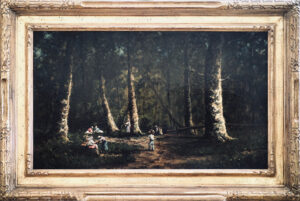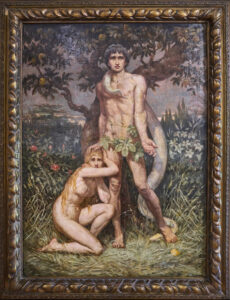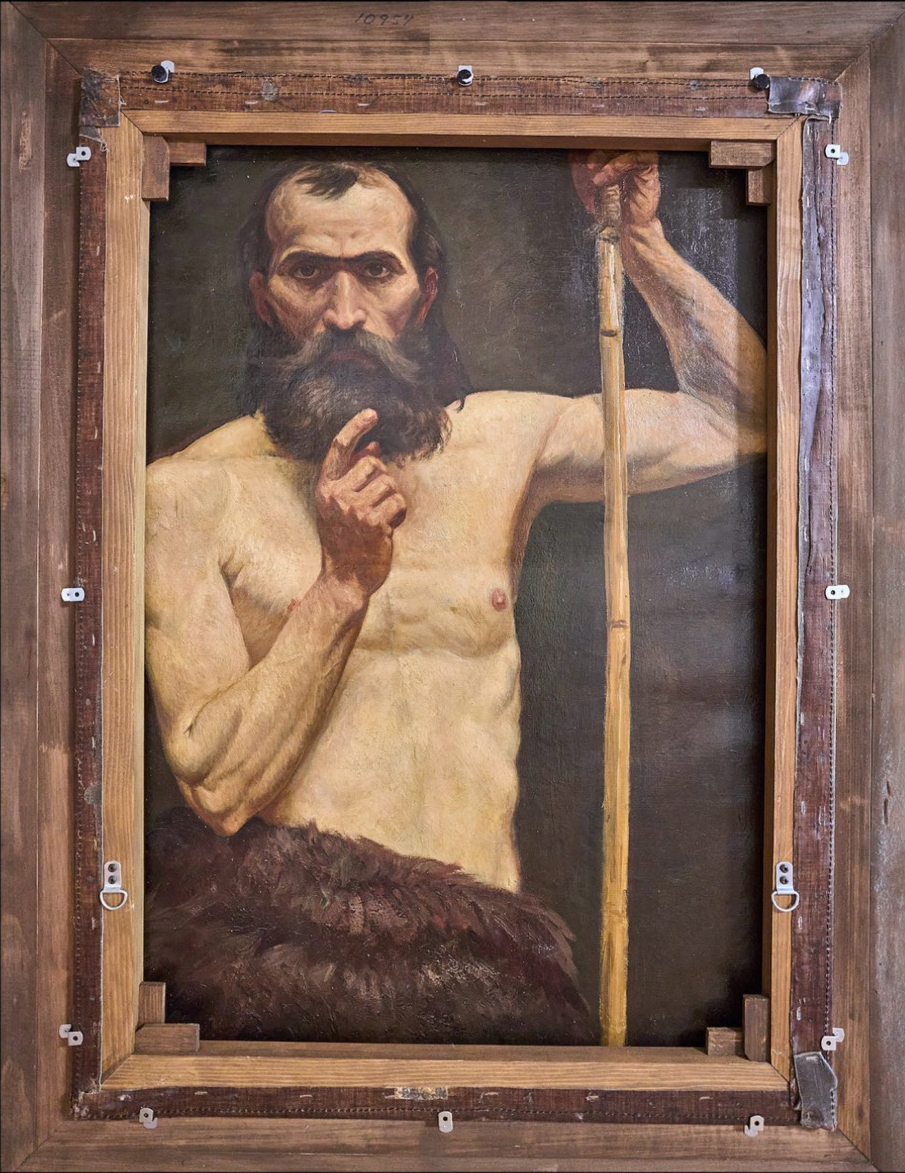Contact:
S. Edward Burns
Manager, Artworks Annuity Group, LLC
Mobile: (617) 981-1579
Email: s.edward.burns@gmail.com
Three Significant 19th Century Paintings Available For Sale
Artworks Annuity Group of Massachusetts announces for sale three superb paintings by American Renaissance master John La Farge (1835-1910): “Forest of Fontainebleau” of 1891, “Portrait of William Morris Hunt” of 1870, and his monumental symbolist work, “Adam and Eve” of 1900, all from a third-generation private art collection in Newport, Rhode Island.
This exclusive for sale offering of these three historically significant artworks marks the first paintings by the artist to the marketplace in over two decades. With fewer than 50 extant oil paintings of the 250 oils completed by La Farge in his lifetime mentioned in his 1910 New York Times obituary by his son Henry La Farge, this landscape, portrait and allegorical biblical work represent major achievements in the artist’s career.
Born in 1835, John La Farge studied with Thomas Couture in 1856 where he met Édouard Manet, just three years his senior, a major influence on his work, and in 1859 with American Barbizon painter, William Morris Hunt, both of whom studied directly with Jean-François Millet. A central figure in the American Renaissance, La Farge is considered a master craftsman in multiple media, arguably the greatest stained glass artist of the 19th century, as well as a brilliant writer, watercolorist, illustrator, muralist, interior designer and oil painter.
The most valuable La Farge oil paintings sold, both landscapes, were “Paradise Valley” (1866-68) by Christie’s auction on May 23, 1996, for $2,202,500 and “The Last Valley-Paradise Rocks” (1867-68) again by Christie’s on November 29, 2000, for $2,096,000, to the Terra Foundation for American Art, Chicago and The National Gallery, Washington, DC, respectively.
These three remarkable oils are expected to sell for 2 to 4 million dollars for “Forest of Fontainebleau” and 4 to 8 million dollars for the “Adam and Eve / Hunt” double portrait, with stated preference by the paintings’ private art collector owner for a major museum acquisition.
These three significant artworks—a Barbizon landscape, a Tonalist portrait, and a Symbolist figure painting—reveal the scope and breadth of John La Farge’s remarkable technical skills and vision as an oil painter, and the evolution of his highly individual style.
The paintings are available for private and scheduled public viewings in Boston.
 One of only three known major landscapes, and with a sight size of 18 x 29 3/4 inches, “Forest of Fontainebleau” is a late work in the French Barbizon tradition. In this evocative forest scene, John La Farge employs the ground glass technique, and a totally original chiaroscuro and perspective, to evoke the majesty of the French forest of Fontainebleau, a favorite sojourn of Parisians in summer.
One of only three known major landscapes, and with a sight size of 18 x 29 3/4 inches, “Forest of Fontainebleau” is a late work in the French Barbizon tradition. In this evocative forest scene, John La Farge employs the ground glass technique, and a totally original chiaroscuro and perspective, to evoke the majesty of the French forest of Fontainebleau, a favorite sojourn of Parisians in summer.
This artwork was restored in the early 1960s by Charles Hulett, Hollywood’s premier restorer and appraiser till his death in 1971, who mounted and preserved the substantial canvas on museum-grade masonite. Hulett dates the painting to the late 1880s, the most productive and profitable year of John La Farge’s career.
Upon investigation in late 2023, by art appraiser Barbara Sussman (Fog Hill & Co.) of original artworks at The Metropolitan Museum, and further research in the La Farge family archives at the Beinecke Library at Yale University, “Forest of Fontainebleau” was created likely in 1891, after his travels with his friend Henry James in 1890 to The South Seas, upon his last trip to Brittany where his beloved French aunt lived.
 In this monumental biblical work, John La Farge intertwines Adam and Eve with the serpent, not The Devil but a white python, as the Tree of Knowledge, whose tripartite leaves recall The Trinity, shields his shame the moment the fruit falls from his hands. The centralized triangular contrapposto, derived from his years of studying the effects of the great Italian Renaissance artworks, creates a perfect dimensional harmony, a sculpture in paint, and we, the viewer, stand in the place of judgment, of God.
In this monumental biblical work, John La Farge intertwines Adam and Eve with the serpent, not The Devil but a white python, as the Tree of Knowledge, whose tripartite leaves recall The Trinity, shields his shame the moment the fruit falls from his hands. The centralized triangular contrapposto, derived from his years of studying the effects of the great Italian Renaissance artworks, creates a perfect dimensional harmony, a sculpture in paint, and we, the viewer, stand in the place of judgment, of God.
This relatively shocking and deeply meaningful canvas painting would have been considered scandalous at the time for its overt nudity, and its sensual synthesis of Realism and Symbolism—the two opposing movements of thought that followed Romanticism—into a meditation upon original sin. Though he paints them with different-color hair, the models (likely two of his nine brilliant and bohemian children) have the same features and expressions. Those who are familiar with La Farge’s stained glass windows in Boston’s Trinity Church will immediately recognize these are the eyes and faces of his saints.
 Verso, a much earlier but no less brilliant tonalist portrait of his beloved teacher, American Barbizon painter William Morris Hunt (1824-1879), whose sallow visage and emaciated frame fill the canvas with an eerie presence, with full direct gaze like his children Eve and Adam on the other side. Hunt appears as a caveman holding a bamboo pole and adorned only in the hide of a wooly mammoth, a primitive god of painting.
Verso, a much earlier but no less brilliant tonalist portrait of his beloved teacher, American Barbizon painter William Morris Hunt (1824-1879), whose sallow visage and emaciated frame fill the canvas with an eerie presence, with full direct gaze like his children Eve and Adam on the other side. Hunt appears as a caveman holding a bamboo pole and adorned only in the hide of a wooly mammoth, a primitive god of painting.
Darwin’s theory of evolution was published in 1859, and the first cave paintings were discovered in Spain in 1868. The painting is certainly inspired by these earth-shattering revelations in science, of which a polymath as erudite as John La Farge would have been well aware. William Morris Hunt, who died by suicide in 1879 at age 55, would have been 45-50 years old at the time. Measuring 42 x 30 inches, this double portrait is likely La Farge’s most important oil painting, both by its size and brilliant conception.
Artworks Annuity Group is a US-based company located in the Commonwealth of Massachusetts and organized for the sale of artworks by historically significant artists including our exclusive representation of astute art collectors worldwide.
